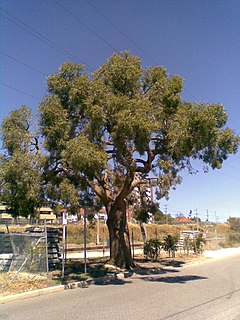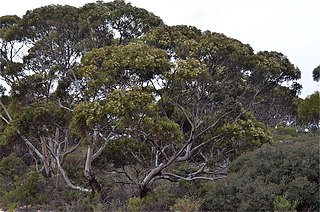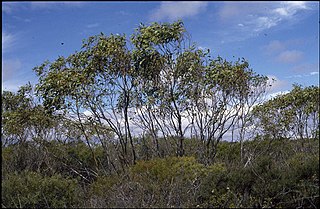
Eucalyptus pyriformis, commonly known as pear-fruited mallee or Dowerin rose, is a species of low, straggly mallee that is endemic to Western Australia. It has smooth greyish brown bark sometimes with ribbony bark near the base, egg-shaped to lance-shaped adult leaves, flower buds in groups of three, red, pinkish or creamy white flowers and down-turned, conical fruit with prominent ribs.

Eucalyptus todtiana, commonly known as coastal blackbuttpricklybark or dwutta, is a species of tree or a mallee that is endemic to the west coast of Western Australia. It has rough, fibrous and flaky bark on the trunk, smooth bark on the branches, lance-shaped adult leaves, flower buds in groups of between seven and eleven, white flowers and cup-shaped to hemispherical fruit.

Eucalyptus gracilis, commonly known as yorrell or white mallee, is a species of mallee or small tree endemic to Australia, where it is found in south-western New South Wales], Victoria, South Australia and Western Australia. It has smooth white bark, usually with rough, fibrous or flaky bark on the lower stems, linear to narrow lance-shaped adult leaves, flower buds in group of between seven and eleven and cup-shaped, cylindrical or barrel-shaped fruit.

Eucalyptus aquilina, commonly known as the Mount Le Grand mallee, is a mallee that is endemic to a small area in the south-west of Western Australia. It has smooth white and grey bark, lance-shaped, often curved leaves, top-shaped or diamond-shaped flower buds, white to cream-coloured flowers and cone-shaped fruit on a down-curved peduncle.

Eucalyptus absita, commonly known as the Badgingarra box, is a mallee that is endemic to a small area near Badgingarra in Western Australia. It has smooth gray bark, sometimes fibrous near its base, white flowers and conical to cup-shaped fruit.

Eucalyptus × balanites, commonly known as Cadda Road mallee, is a tree or a mallee that is endemic to a small area of the south-west of Western Australia. It has rough, corky or flaky bark, lance-shaped adult leaves, flower buds in groups of eleven, creamy-white flowers and hemispherical to cup-shaped fruit.

Eucalyptus capillosa, commonly known as wheatbelt wandoo, or mallee wandoo, is a species of tree or mallee that is endemic to Western Australia. It has smooth, grey bark, lance-shaped to elliptic adult leaves, spindle-shaped flower buds in groups of nine to thirteen, white flowers and barrel-shaped to cylindrical fruit.

Eucalyptus deflexa, commonly known as Lake King mallee, is a species of mallee that is endemic to Western Australia. It has smooth grey to whitish bark, linear to elliptic or curved adult leaves, pendulous flower buds arranged in groups of seven, cream-coloured or pink flowers and pendulous barrel-shaped fruit.

Eucalyptus gittinsii, commonly known as northern sandplain mallee, is a species of mallee that is endemic to Western Australia. It has smooth greyish bark, sometimes with rough flaky bark near the base, lance-shaped to curved adult leaves, flower buds in groups of three, whitish flowers and cylindrical to barrel-shaped fruit.

Eucalyptus insularis, commonly known as Twin Peak Island mallee, or North Twin Peak Island mallee, is a species of mallee that is endemic to a small area of southern Western Australia. It has mostly smooth bark, dull green, linear adult leaves, flower buds in group of between nine and twenty or more, white flowers and barrel-shaped fruit.

Eucalyptus johnsoniana, commonly known as Johnson's mallee, is a species of mallee that is endemic to Western Australia. It has smooth, greyish brown bark, sometimes with flaky to fibrous brownish bark at the base, lance-shaped adult leaves, flower buds in groups of seven, creamy white flowers and shortened spherical fruit with an unusually small opening.

Eucalyptus kingsmillii is a mallee that is native to the arid central areas of Western Australia and South Australia.

Eucalyptus lateritica, commonly known as laterite mallee, is a species of mallee that is endemic to a small area in the south-west of Western Australia. It has rough bark on the lower half of the trunk, smooth grey bark above, lance-shaped adult leaves, flower buds in groups of nine or eleven, white flowers and shortened spherical fruit.
Eucalyptus leprophloia, commonly known as scaly butt mallee, is a species of mallee that is endemic to a small area in Western Australia. It has rough, fibrous bark on the base of the trunk, smooth bark above, lance-shaped adult leaves, flower buds in groups of seven to eleven, white flowers and cup-shaped to barrel-shaped fruit.
Eucalyptus pluricaulis, commonly known as the purple-leaved mallee, is a species of mallee that is endemic to Western Australia. It has smooth bark, dull bluish green, lance-shaped leaves, flower buds in groups of between nine and fifteen, pale yellow flowers and cylindrical to barrel-shaped fruit.

Eucalyptus suberea, commonly known as Mount Lesueur mallee or cork mallee, is a species of mallee or a small tree that is endemic to a small area on the west coast of Western Australia. It has rough bark on some or all of the trunk, smooth white bark above, lance-shaped adult leaves, flower buds in groups of eleven to twenty or more, white flowers and shortened spherical fruit.
Eucalyptus conveniens is a species of small mallee or shrub that is endemic to a small area on the west coast of Western Australia. It has smooth bark, sometimes with a short stocking of rough bark near its base, lance-shaped to egg-shaped or elliptic adult leaves, flowers buds in groups of three, whitish flowers and glaucous, barrel-shaped fruit.
Eucalyptus cuprea, commonly known as the mallee box, is a species of mallee that is endemic to the west coast of Western Australia. It has rough, flaky bark on the base of its trunk, smooth coppery-coloured bark above, lance-shaped adult leaves, flower buds in groups of seven, creamy white flowers and conical to cup-shaped fruit.

Eucalyptus diminuta, commonly known as the spring mallee, is a species of mallee that is endemic to south-west of Western Australia. It has smooth, silvery to greyish bark, sometimes with rough flaky bark near the base, lance-shaped adult leaves, pendulous, elongated flower buds arranged in groups of seven, creamy white flowers and cup-shaped to bell-shaped fruit.

Eucalyptus diversifolia, commonly known as the soap mallee, coastal white mallee, South Australian coastal mallee, or coast gum is a species of mallee that is endemic to an area along the southern coast of Australia. It has smooth bark, lance-shaped adult leaves, flower buds in groups of between seven and eleven, white to creamy yellow flowers and cup-shaped fruit.

















